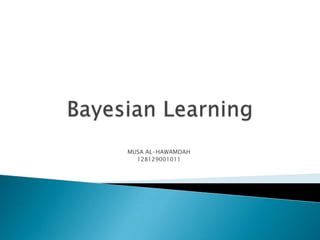
Bayes learning
- 1. MUSA AL-HAWAMDAH 128129001011
- 2. Bayesian Decision Theory came long before Version Spaces, Decision Tree Learning and Neural Networks. It was studied in the field of Statistical Theory and more specifically, in the field of Pattern Recognition. Bayesian Decision Theory is at the basis of important learning schemes such as the Naïve Bayes Classifier, Learning Bayesian Belief Networks and the EM Algorithm. Bayesian Decision Theory is also useful as it provides a framework within which many non- Bayesian classifiers can be studied
- 3. Bayesian reasoning is applied to decision making and inferential statistics that deals with probability inference. It is used the knowledge of prior events to predict future events. Example: Predicting the color of marbles in a baske.t
- 6. The Bayes Theorem: P(h) : Prior probability of hypothesis h P(D) : Prior probability of training data D P(h/D) : Probability of h given D P(D/h) : Probability of D given h
- 7. D : 35 year old customer with an income of $50,000 PA. h : Hypothesis that our customer will buy our computer. P(h/D) : Probability that customer D will buy our computer given that we know his age and income. P(h) : Probability that any customer will buy our computer regardless of age (Prior Probability). P(D/h) : Probability that the customer is 35 yrs old and earns $50,000, given that he has bought our computer (Posterior Probability). P(D) : Probability that a person from our set of customers is 35 yrs old and earns $50,000.
- 8. Example: h1: Customer buys a computer = Yes h2 : Customer buys a computer = No where h1 and h2 are subsets of our Hypothesis Space „H‟ P(h/D) (Final Outcome) = arg max{ P( D/h1) P(h1) , P(D/h2) P(h2)} P(D) can be ignored as it is the same for both the terms
- 9. Theory: Generally we want the most probable hypothesis given the training data hMAP = arg max P(h/D) (where h belongs to H and H is the hypothesis space)
- 11. If we assume P(hi) = P(hj) where the calculated probabilities amount to the same Further simplification leads to: hML = arg max P(D/hi) (where hi belongs to H)
- 12. P (buys computer = yes) = 5/10 = 0.5 P (buys computer = no) = 5/10 = 0.5 P (customer is 35 yrs & earns $50,000) = 4/10 = 0.4 P (customer is 35 yrs & earns $50,000 / buys computer = yes) = 3/5 =0.6 P (customer is 35 yrs & earns $50,000 / buys computer = no) = 1/5 = 0.2
- 13. Customer buys a computer P(h1/D) = P(h1) * P (D/ h1) / P(D) = 0.5 * 0.6 / 0.4 Customer does not buy a computer P(h2/D) = P(h2) * P (D/ h2) / P(D) = 0.5 * 0.2 / 0.4 Final Outcome = arg max {P(h1/D) , P(h2/D)} = max(0.6, 0.2) => Customer buys a computer
- 15. It is based on the Bayesian theorem It is particularly suited when the dimensionality of the inputs is high. Parameter estimation for naive Bayes models uses the method of maximum likelihood. In spite over-simplified assumptions, it often performs better in many complex realworl situations. Advantage: Requires a small amount of training data to estimate the parameters
- 17. X = ( age= youth, income = medium, student = yes, credit_rating = fair) A person belonging to tuple X will buy a computer?
- 18. Derivation: D : Set of tuples ** Each Tuple is an „n‟ dimensional attribute vector ** X : (x1,x2,x3,…. xn) Let there be „m‟ Classes : C1,C2,C3…Cm Naïve Bayes classifier predicts X belongs to Class Ci iff **P (Ci/X) > P(Cj/X) for 1<= j <= m , j <> i Maximum Posteriori Hypothesis **P(Ci/X) = P(X/Ci) P(Ci) / P(X) **Maximize P(X/Ci) P(Ci) as P(X) is constant
- 19. With many attributes, it is computationally expensive to evaluate P(X/Ci). Naïve Assumption of “class conditional independence”
- 20. P(C1) = P(buys_computer = yes) = 9/14 =0.643 P(C2) = P(buys_computer = no) = 5/14= 0.357 P(age=youth /buys_computer = yes) = 2/9 =0.222 P(age=youth /buys_computer = no) = 3/5 =0.600 P(income=medium /buys_computer = yes) = 4/9 =0.444 P(income=medium /buys_computer = no) = 2/5 =0.400 P(student=yes /buys_computer = yes) = 6/9 =0.667 P(student=yes/buys_computer = no) = 1/5 =0.200 P(credit rating=fair /buys_computer = yes) = 6/9 =0.667 P(credit rating=fair /buys_computer = no) = 2/5 =0.400
- 21. P(X/Buys a computer = yes) = P(age=youth /buys_computer = yes) * P(income=medium /buys_computer = yes) * P(student=yes /buys_computer = yes) * P(credit rating=fair /buys_computer = yes) = 0.222 * 0.444 * 0.667 * 0.667 = 0.044 P(X/Buys a computer = No) = 0.600 * 0.400 * 0.200 * 0.400 = 0.019
- 22. Find class Ci that Maximizes P(X/Ci) * P(Ci) =>P(X/Buys a computer = yes) * P(buys_computer = yes) = 0.028 =>P(X/Buys a computer = No) * P(buys_computer = no) = 0.007 Prediction : Buys a computer for Tuple X
- 23. http://en.wikipedia.org/wiki/Bayesian_probability http://en.wikipedia.org/wiki/Naive_Bayes_classifier http://www.let.rug.nl/~tiedeman/ml05/03_bayesian_hando ut. pdf http://www.statsoft.com/textbook/stnaiveb.html http://www.cs.cmu.edu/afs/cs.cmu.edu/project/theo-2/www/mlbook/ch6.pdf Chai, K.; H. T. Hn, H. L. Chieu; “Bayesian Online Classifiers for Text Classification and Filtering”, Proceedings of the 25th annual international ACM SIGIR conference on Research and Development in Information Retrieval, August 2002, pp 97-104. DATA MINING Concepts and Techniques,Jiawei Han, Micheline Kamber Morgan Kaufman Publishers, 2003.
- 24. Thank you
